-
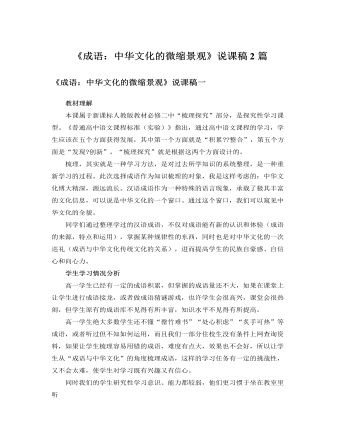
人教版高中语文必修2《成语:中华文化的微缩景观》说课稿2篇
(三)教学目标1、明确成语的来源,了解成语的结构特点。2、学习积累成语的方法。3、梳理学习过的成语,做到能正确理解、使用所学的常用成语。(四)教学重点和难点1、学习积累成语的方法。2、正确理解、使用所学的常用成语。二、说教法新的《高中语文课程标准》要求学生主动去发现问题、解决问题,教师是课堂学习的组织者、参与者,是课堂的主导,而不是课堂的主体。而且,新的课程标准要求学生“能围绕所选择的目标加强语文积累,在积累的过程中,注重梳理”。在这种前提下,本节课可以采取以下方法:由于这种梳理是对学生已有的知识进行归纳分类,可能显得比较枯燥。为了避免这种枯燥感,可以采取设置情境和分组竞答的方法,调动学生的积极性。
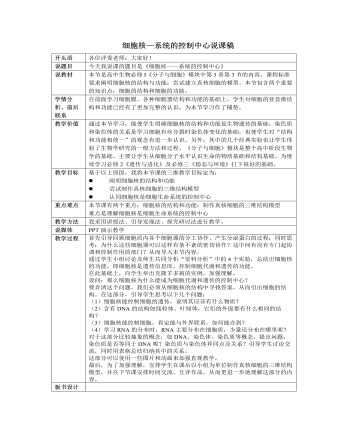
人教版高中生物必修1细胞核—系统的控制中心说课稿
首先引导回顾细胞质内各个细胞器的分工协作、产生分泌蛋白的过程;同时思考:为什么这些细胞器可以这样有条不紊的密切协作?这中间有没有专门起协调和控制作用的部门?从而导入本节内容。通过学生小组讨论及师生共同分析“资料分析”中的4个实验,总结出细胞核的功能,即细胞核是遗传信息库,控制细胞代谢和遗传的功能。在此基础上,向学生举出克隆羊多莉的实例,加强理解。设问:那么细胞核为什么能成为细胞代谢和遗传的控制中心?要弄清这个问题,我们必须从细胞核的结构中寻找答案,从而引出细胞的结构。在这部分,引导学生思考以下几个问题:(1)细胞核能控制细胞的遗传,说明其应该有什么物质?(2)含有DNA的结构如线粒体、叶绿体,它们的外面都有什么相同的结构?(3)细胞核能控制细胞,肯定能与外界联系,如何能办到?(4)学习RNA的分布时,RNA主要分布在细胞质,少量还分布在哪里呢?

人教版高中生物必修1细胞中的元素和化合物说课稿
一、说教材的地位和作用《细胞中的元素和化合物》是人教版教材生物必修一第二章第1节内容。《细胞中的元素和化合物》这一节,首先在节的引言中,明确指出自然界的生物体中的元素是生物有选择地从无机自然界中获得的,没有一种元素是细胞特有的。但细胞与非生物相比,各元素的含量又大不相同。说明生物界与非生物界具有统一性和差异性。这部分内容较为浅显,但是结论非常重要,对于学生了解生物的物质性具有重要意义二、说教学目标根据本教材的结构和内容分析,结合着高一年级学生的认知结构及心理特征,我制定了以下的教学目标:1、知识目标:知道组成细胞的主要元素;知道为什么碳元素是构成细胞的基本元素2、能力目标:学会检测生物组织中的糖类、脂肪和蛋白质的方法。(1)通过对C元素的分析,说明有机化合物形成的可能性及必然性,初步培养学生跨学科综合分析问题的能力。(2)通过对组成细胞中的元素的百分比的分析,通过对不同化合物的质量分数的学习,培养学生理解、思考和分析问题的能力。
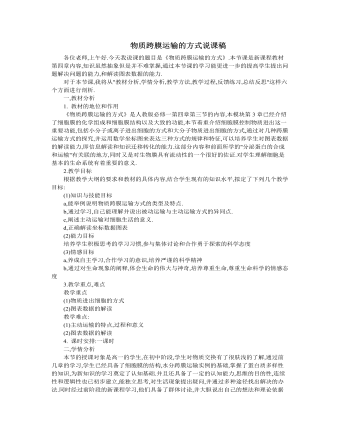
人教版高中生物必修1物质跨膜运输的方式说课稿
(4)提出问题:三种运输方式有哪些异同 组织学生分析填表,反馈和纠正.提出问题:影响自由扩散,协助扩散和主动运输速度的主要因素各是什么 画出细胞对某物的自由扩散,协助扩散和主动运输速度随细胞外浓度的改变而变化的曲线图组织学生分组讨论,并作图,展示各组的成果.教学说明:本环节巩固理论知识是对课本知识扩展和对重点,难点内容的深入理解和总结,只有理解了三种运输方式的异同,才能完成本环节教学任务,既突显书本知识,又培养学生的团结协作的精神,提高学生制做图表的能力和抽象化思维能力的形成.2.大分子的运输引导学生回忆分泌蛋白的分泌过程,得出胞吐现象,提出问题:那大家知道白细胞是如何吃掉病菌的吗 显示有关图片.强调:胞吞和胞吐作用都需要能量提出问题:胞吞和胞吐体现了细胞膜结构的特点是什么 与书本前面知识相联系.(四)技能训练指导学生就《技能训练》部分进行讨论五,反馈练习1.教师小结几种运输方式,特别是自由扩散,协助扩散和主动运输的特点
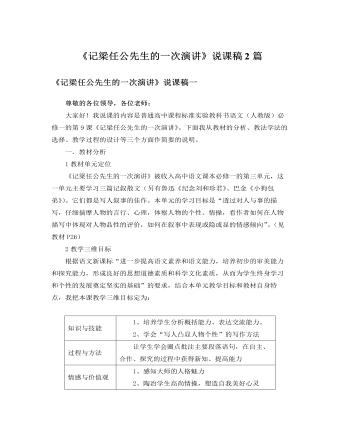
人教版高中语文必修1《记梁任公先生的一次演讲》说课稿2篇
6、思考:作者心目中的梁启超是什么形象呢?明确:梁任公是位有学问,有文采,有热心肠的学者。由学生找出文中体现梁启超学问、文采的句子。教师展示幻灯。补充介绍:文采不仅体现在书面,也能从流畅的口语表达中反映。《箜篌引》短短十六字蕴涵了什么故事,竟让梁启超描述得生动感人以至作者多年后还印象深刻呢?《箜篌引》出自《汉乐府诗》,记叙了一个悲惨壮烈的故事:朝鲜水兵在水边撑船巡逻时,见一个白发狂夫提壶渡江,被水冲走。他的妻子劝阻不及,悲痛欲绝,取出箜篌对着江水反复吟唱。一曲终了,她也投河随夫而去。朝鲜水兵回家向自己的妻子丽玉讲述了这个故事,丽玉援引故事中的悲情,创作了这首歌曲,听过的人无不动容。7、朗读训练了解《箜篌引》的故事后,请各小组选派代表朗读,由学生点评,体会梁启超演讲技巧的高超。8、文中说梁任公是个热心肠的人,你同意吗?通过结尾段的“热心肠”转入对其人格的分析。

人教版高中语文必修2《在马克思墓前的讲话》说课稿2篇
(二)、课前检测:1.课文从哪几方面介绍马克思的伟大贡献?具体介绍一下有哪些伟大贡献?2.概述课文的结构。此项设置主要是让学生熟悉课文,为下文揣摩语言打基础。“温故知新”。(三)、新课讲授:1.先引导学生完成一些语句的揣摩理解,然后师生共同归纳揣摩重点语句的方法。问题1:为什么说马克思“停止思想”“安静地睡着了”“永远地睡着了”?问题2:讳饰修辞手法的运用有什么作用?答案:表达了作者对马克思的哀悼与尊敬以及不忍再说,而又不得不说的沉痛心情。以上两个问题重在引导学生从重点句段入手揣摩语言。问题3:第三段是一个复杂的单句,它的句子主干是什么?冒号后面作为宾语的复指成分可以分为哪几层意思?“正像达尔文……一样”在句子中是什么成分?起什么作用?
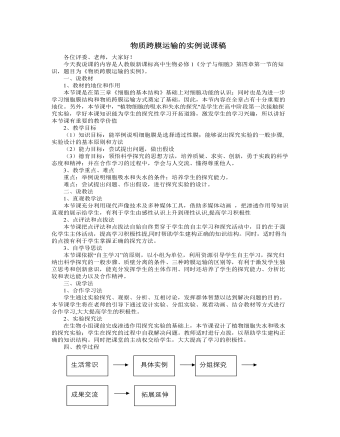
人教版高中生物必修1物质跨膜运输的实例说课稿
(四)、成果交流教师出示成熟植物细胞图,提出原生质层的概念,小组交流,教师点拨,得出结论:1、原生质层相当于半透膜2、外界溶液浓度大于细胞液浓度---细胞失水(质壁分离)3、外界溶液浓度小于细胞液浓度---细胞失水(质壁分离复原)教师出示有关细胞选择性吸收离子的数据资料。引导学生发现并探究出不同植物对同一离子吸收量不同,同一植物对不同离子吸收量也不同,得出结论:4、细胞膜具有选择透过性(五)拓展延伸如何用已有知识和技能鉴别两种蔗糖溶液浓度的大小?用0.1g/mg 0.8g/mg的蔗糖溶液分别做前面的探究实验会有什么不同的结果?你得出的结论是什么?引导学生总结出发生质壁分离和质壁分离复原的条件。五、板书设计好的板书就像一份微型教案,此板书力图全面而简明的将授课内容传递给学生,清晰直观,便于学生理解和记忆,理清文章脉络。
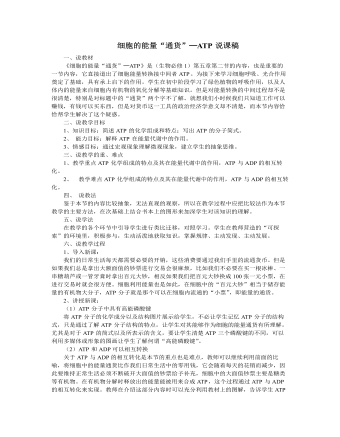
人教版高中生物必修1细胞的能量“通货”─ATP说课稿
(3)ATP的利用关于ATP的利用,一是要讲清楚吸能反应和放能反应与ATP的分解和合成的关系,二是要充分利用教材上的图解,让学生在看懂图解的基础上,讨论ATP还有哪些用途,从而对该图解进行补充和完善。3、课堂小结,强化认识。ATP作为能量的“通货”,在生物体生命活动中具有重要的意义。我们不仅要知道ATP的分子结构,还要掌握ATP是如何行使他的货币能力。4、板书设计结束:本节课设置了一系列问题情境,层层设问,在学生答问、质疑、讨论过程中让学生建构新概念和新的知识体系,并通过教师及时掌握反馈信息,适时点拨、调节,让学生在推理判断中培养良好的思维习惯和对知识的迁移能力,而且通过留出一定的时间让学生提问,体现了以学生为主体的思想。我的说课完毕,谢谢大家。
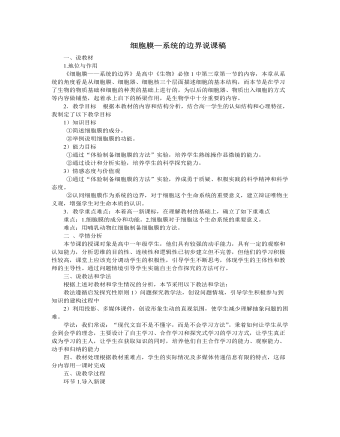
人教版高中生物必修1细胞膜—系统的边界说课稿
(1)问题串设计:①选材:选择什么细胞做材料?②为什么选择哺乳动物成熟的红细胞做实验材料?(在教师的指导下讨论分析)③怎样才能获得细胞膜?(教师讲授)(2)指导学生观看多媒体播放教参CD中的这个实验,同时教师加以讲解(3)学生分组实验(4)总结实验并加以评价设计意图:体会实验材料的正确选择对于科学研究的重要性,提高学生科学研究素养。学生在已有知识的基础上思考,尝试找出实验的原理,实现亲身体验、自主思考的的过程,这样加深学生的印象。培养学生拓展迁移的能力,使学生认识先进的生物学研究仪器。环节3.细胞膜的功能(1)学生自主学习并归纳总结:P42(2)展示图片加强理解:图片(3)讨论:联系生活实际,列举现实生活中有什么东西与细胞膜的功能相近?设计意图:提高学生自主学习的能力;注重与现实生活的联系,引导学生利用类比的方法解决问题,便于学生理解和掌握。环节4. 植物细胞的细胞壁
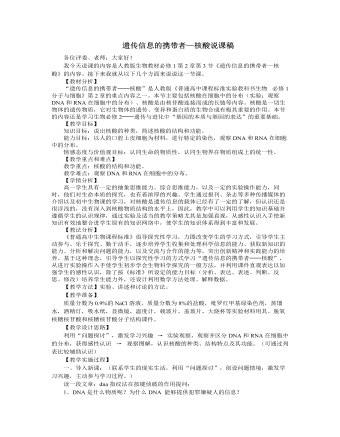
人教版高中生物必修1遗传信息的携带者—核酸说课稿
二、问题导学,主动探究,获取知识:(给学生机会,参与学习过程,有利于对知识的感知和对科学研究方法的领悟。有利于突破难点。)通过上面的讨论及对初中相关知识的回忆可知,核酸是生物体内的遗传物质。提问:1 、你知道生物体内的核酸有几种?它们在细胞中是如何分布的? 2 、如何观察核酸在细胞中的分布? 针对问题,引导学生阅读教材及相关实验内容,组织学生进行实验。让学生阅读课文及“观察DNA 和RNA 在细胞中的分布”实验,回答问题。实验后要倾听、总结学生的实验结论,继续引发学生思考:原核细胞的DNA位于细胞内的什么部位?三、加工、整合信息, 构建知识体系。(充分利用教材中图示和课件的直观性特点,发挥学生主体作用,引导学生通过观察、讨论,感知知识的形成,突出重点)组织学生阅读教材并讨论: 1、核酸同蛋白质一样,也是生物大分子物质,那么,核酸由哪些元素组成?组成它的基本单位是什么? 2、DNA 和RNA的化学组成有何异同? 3、组成核酸的碱基、五碳糖、核苷酸各有几种?
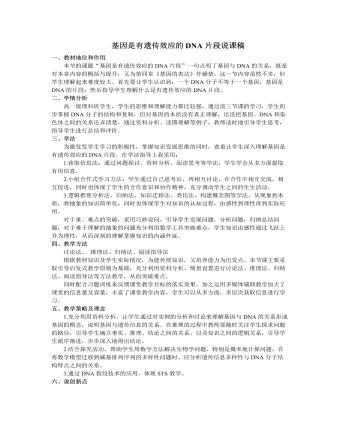
人教版高中生物必修2基因是有遗传效应的DNA片段说课稿
1.基因的化学组成:每个基因含有成百上千个脱氧核苷酸。讲述:基因的脱氧核苷酸排列顺序代表遗传信息。2.基因不同的实质:不同的基因,四种脱氧核苷酸的排列顺序不同,但是每个基因都有特定的排列顺序。3.基因的位置:染色体是基因的主要载体,每个染色体含有一个DNA分子,每个DNA分子含有多个基因,基因在染色体上呈直线排列。4.基因是有遗传效应的DNA片段这就是说,基因是DNA的片段,但必须具有遗传效应(指具有复制、转录、翻译、重组突变及调控等功能)。有的DNA片段属间隔区段,没有控制性状的作用,这样的DNA片段就不是基因。控制某种性状的基因有特定的DNA片段,蕴含特定的遗传信息,可以切除,可以拼接到其他生物的DNA上,从而获得某种性状的表达。例如:把牛的胰岛素基因拼接到大肠杆菌的DNA上,大肠杆菌可以生产胰岛素。

人教版高中生物必修2基因指导蛋白质的合成说课稿
六、说教学反思由于本节内容抽象复杂, 插图多, 涉及的物质种类也比较多,应要求学生做好课前预习。教学中,在处理主干知识和侧枝内容的关系时,要做到合理分配时间,明确不同内容的教学要求。教师要注意将知识及时进行归纳、比较和总结。要让学生了解各个知识点间的内在关系,又要能简洁、清晰地概述转录和翻译的过程。教师在备课时,一定要仔细分辨并揣摩插图所表达的意思,并能将不同的插图内容与教学流程有机地结合起来。在对插图的处理上,还应分清主次和轻重。教材在呈现教学内容时,采用图文并茂的方式来揭示转录与翻译的动态过程。因此,教师不仅要利用插图达到形象和直观的教学效果,还应配合教材中的文字描述作深入浅出的讲解,使文字信息与图形信息结合起来,让学生感知到基因的表达是一个多层次的、动态的、相互协调和配合的过程。尽可能利用多媒体课件进行教学。多媒体课件可以形象、生动地反映基因表达的过程,这是纸质教材难以做到的。
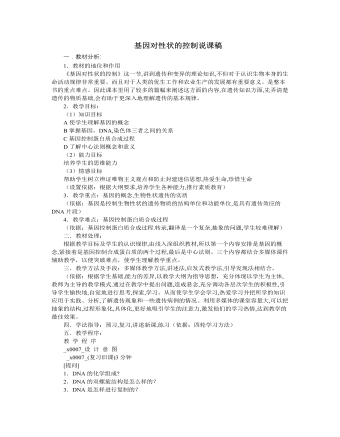
人教版高中生物必修2基因对性状的控制说课稿
7.让学生阅读基因控制蛋白质合成的过程(转录,翻译)13分钟 动画演示“转录,翻译”过程两次,让学生有个整体印象。 培养学生自学习惯,突出教学过程中的学生为主体的教学思想。 8.配合动画引导学生根据预习逐段讲解。 注意问题(1)转录,翻译的地点,模板,生成物不同。因为这是一个极其复杂的过程,避免学生在学习过程中相混肴.(2)这个问题的阐明能为后面“密码子”的概念做好铺垫,避免学生搞不清“遗传密码”和“遗传信息”两个概念。 9.打出板书。 通过动画演示,加深学生的理解和掌握,提高学习效率。 10.重播全过程动画,引导学生讲述。7分钟 _x0007_加深认识,完成从量变到质变的飞跃。 11.过渡:就这样,以DNA为模板合成信使RNA,再以信使RNA为模板,以转运RNA为运载工具,使氨基酸在核糖体中按照一定的顺序排列起来,合成了与亲代一样的蛋白质,从而显现出与亲代同样的性状。从而引出“中心法则”。

人教版高中生物必修1生命活动的主要承担者—蛋白质说课稿
第五,蛋白质的功能。蛋白质功能具有多样性,由学生对照教材,进行总结。为什么蛋白质有那么多功能呢?根据我们学习生物学的经验可知道:生物的结构决定功能。再要求刚才的那四个同学上台组合多肽链。以不同位置组合,就会形成很多种多肽链,进而形成很多种蛋白质。每一种蛋白质都有其特定的功能,所以蛋白质具有多样性,其功能也具有多样性。第六,总结。蛋白质是细胞和生物体中重要的有机化合物,是一切生命活动的主要承担者。蛋白质的多样性是形形色色生物和绚丽多彩生命活动的物质基础。(可以由学生总结)第七,教学评价。由于只有一节课时间,课堂上对重点、难点知识的解析还不能做到举一反三的深度,因此尽管学生课堂反应热烈,对知识点的接受程度也达到了预期的要求,但在做课后练习时,也会出现一些问题。所以传统的讲练结合还是要结合起来运用才能取得更好的效果。为此本节内容需要2课时来完成。
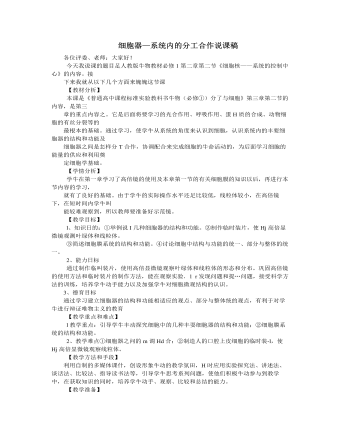
人教版高中生物必修1细胞器—系统内的分工合作说课稿
②与学牛的牛活经验相关,有利激发学列的兴趣。⑧利用多媒体让学牛通过观看、比较、讨论,加深理解f-J利掌握细胞内的牛要细胞器的结构及其功能。④学牛白丰学习,丰动建构新知识。⑤为完成后面的达标图表做充分的准备。4、概括反馈:①设讣达标表格,引导学牛完成。②应用该表格进行小结。③推荐相关网站,以解决课后遇到的附加题。这样设置的理由是①通过完成表格,归纳各种细胞器的结构和功能,使学牛更好的掌握本节课的内容。②培养学牛的分析问题和归纳总结的能力③培养学牛的竞争意识和团队合作精神。④拓展了教育资源,为学牛提供了一个白丰学习的空间。[课堂小结]请4-5位学牛来总结本节课的学刊内容和白己掌握的情况。请教师重新出示“八种细胞器的比较表”和“植物细胞和动物细胞的比较表”对本节内容的知识点、重点、难点进行总结。
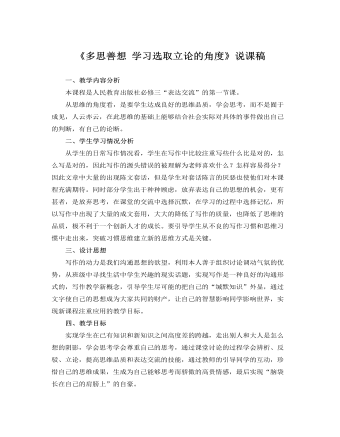
人教版高中语文必修3《多思善想 学习选取立论的角度》说课稿
谈到这,如果有人会说这仅仅是在于我个人与战场之上,战场之下另当别论,那么,他完全错了。在我小学四年级的语文课上有两个人发言积极,一个姓黄,一个姓康,黄同学发言比康同学更积极,班上的同学常以为黄同学是个了不得的人物,后来,教语文的吴老师曾悄悄地告诉我:班上真正厉害的是康x,那黄x没什么,说的全是“一点通”上的,照搬不误。说到这,我还得厚着脸皮自夸一下,在四年级时,我和康同学是同坐,一次,老师叫我们对一片课文(好象是写黄继光舍身炸暗堡)的一个段落提问题时,我悄悄地对康同学说了一个问题,康同学对我说:“你站起来说嘛。”内向的我遥遥头,康同学便站举手,并起来将我的问题大声地说了出来,结果老师说:“恩,康x的问题提得很好。”
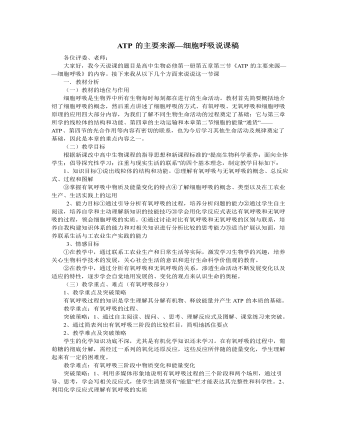
人教版高中生物必修1ATP的主要来源—细胞呼吸说课稿
(一)自主阅读:自主阅读有氧呼吸三阶段内容,明确有氧呼吸的场所、反应物、生成物和释放的能量状况等内容。(二)直观教学:通过多媒体辅助教学软件,化静为动,化抽象为具体, 增强了教学内容的直观性和启发性。 .(三)比较法:学生参与完成有氧呼吸三阶段区别的表格,进行教学反馈;比较有氧呼吸和有机物体外燃烧的不同,进一步认清有氧呼吸的特点。(四)归纳法: 归纳有氧呼吸的概念。三.教学过程分析步骤一: 导入新课 通过问题探讨导入本节内容第三节 ATP的主要来源 ——细胞呼吸步骤二: 联系生活(酵母菌可用于发面和酿酒) 介绍细胞呼吸概念一、细胞呼吸的方式 :有氧呼吸、无氧呼吸步骤三: 回顾第三章细胞器的知识,学习 二、(一)有氧呼吸的主要场所——线粒体的结构
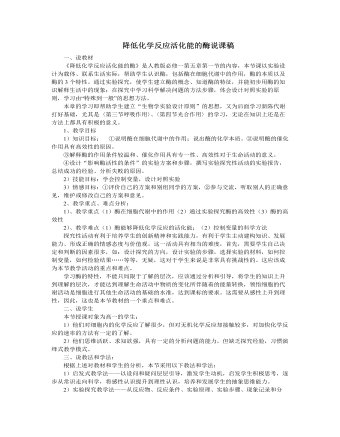
人教版高中生物必修1降低化学反应活化能的酶说课稿
实验是学习生物的手段和基础,是培养学生分析问题、解决问题的能力及创造能力的载体。新课程倡导:强调过程,强调学生探索新知识的经历和获得新知的体验,不能在让教学脱离学生的内心感受,必须让学生追求过程的体验。并且每年高考都有对生物学实验的考查,而且比例越来越重,而学生的失分比例大,主要在于他们没有完整的生物实验设计模式,考虑问题欠缺,本节安排在第二课时完整讲述高中生物学实验设计,是以学生在第一课时和前面探究实验接触的前提下,完整体验生物实验设计模式,为后面学习探究实验打下基础,也为培养学生分析问题、解决问题从一开始就打好基础。五、说教学过程:第一课时联系生活,导入新课,激发学生学习兴趣→细胞代谢→问题探究,酶在代谢中的作用,掌握科学实验方法→酶的本质,运用方法,自主归纳获取新知→小结练习,突出重点易化难点

人教版高中生物必修2孟德尔的豌豆杂交实验说课稿
一、说教材1、教材的地位和作用《孟德尔的豌豆杂交实验(一)》这一课题是高中生物必修2第一章第一节第一部分的内容,是学生学习孟德尔的豌豆杂交实验(二)的基础,也是第二章《减数分裂与受精作用》这节知识的重要基础,又并为后续学习生物变异与生物进化奠基,所以在教材中起到承上启下的作用。因此从这个地位来看,这部分内容不仅是本章的重点,更是整个必修2的重点内容。本节的教学内容是按照孟德尔的探索过程由现象到实质,层层深入地展开的。教材首先介绍了孟德尔的杂交实验方法和观察到的实验现象,接着介绍了孟德尔对实验现象的分析,然后介绍了对分离现象解释的验证,最后归纳总结出分离定律。在教学内容的组织上体现了学科内在逻辑性与学生认识规律的统一。与原教材比较,有了新的突破主要表现在三方面:
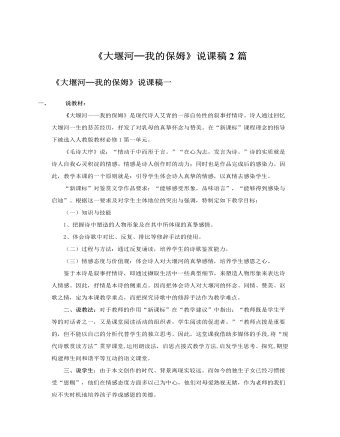
人教版高中语文必修1《大堰河─我的保姆》说课稿2篇
现代诗歌赏读方法四:美读(饱含讴歌与赞美情感再一次有感情地配乐朗读全文,对比前面的朗读,在读中加深情感的领悟。)(五)延伸拓展引进生活的源头活水,用情感来撞开学生的心扉。引导学生找到文章与现实的联系点,抓住这一联系点,让语文回归生活。我设计了“本诗哪些语段让你联想到自己的母亲?讲讲你和母亲的故事。”这个问题是把对大堰河的感情升华为对母亲的感情的过程。这样将语文学习的外延与生活的外延相等,把课文与生活有机地结合在一起。要求学生讲述条理清楚,语言生动。教师可以播放背景音乐,调动学生情感。这样,不仅锻炼了学生的口语表达能力,培养了学生感恩美德,同时也深化了本文的教学难点。现代诗歌赏读方法五:比读(投影出示孟郊《游子吟》比较两诗的异同,并有感情地朗诵。)(六)布置作业。把“你与母亲的故事”整理成一篇文章。





















